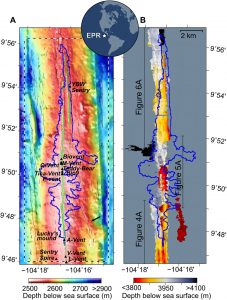By imaging for the first time at high resolution and in 3D the magmatic system under the East Pacific Ridge, an international team led by Milena Marjanović, CNRS researcher at the Institut de Physique du Globe de Paris, sheds light on the morphology of the magma lenses representing the last stages of magma before eruptions of lava on the surface.
The study, published on September 29 in the journal Science Advances, shows that the shape of these small magma reservoirs remembers the processes of magma recharge and drain, influencing the dynamics of future eruptions.

© Marjanovic – CNRS-IPGP
Numerical modeling results show that the architecture of magma plumbing systems between the Earth’s mantle and surface and how magma evolves through these systems play a fundamental role in the construction and evolution of volcanic edifices. However, due to the inaccessibility of most active volcanic systems to high-resolution imaging, the detailed morphology of the most superficial magma reservoirs and the relationship between magma upwelling initiation and eruption dynamics still need to be discovered.

Topography and tectonics of the ocean floor (left) and 3D morphology of magmatic lenses beneath the surface (right) of a segment at the East Pacific Rise. © Marjanovic – CNRS – IPGP
A study published on September 29 in Science Advances by an international team involving scientists from the CNRS, the Institut de Physique du Globe de Paris and Université Paris Cité presents unprecedented high-resolution seismic images that shed light on the small-scale architecture of the network of shallowest magma bodies, located beneath an erupting zone of the East Pacific Rise. These images, the result of a close collaboration with industry experts, which enabled a cutting-edge imaging technique, were obtained by inverting the waveforms of seismic reflection data acquired during a marine research cruise conducted in 2008.
The study reveals that these lenses, which were until now modeled as smooth bodies, in reality present ridges and troughs which are interpreted as zones where repeat dikes (seams of magma which rise from the reservoir up to the surface) nucleate. This peculiar morphology is sculpted by the processes of magma recharge from the mantle and magma extraction towards the surface. The recurrence of these processes leaves an imprint, linked to the concentration of stresses induced by the topography, which contributes to the nucleation of the dikes and the triggering of the rise of magma towards the surface and more broadly to the dynamics of subsequent eruptions.
By including these new results in the latest generation of three-dimensional numerical models, it should now be possible to obtain a more realistic representation of volcanic systems which will contribute to better localization of eruptions, and thus to the improvement of risk assessment.
References:
> Insights into dike nucleation and eruption dynamics from high-resolution seismic imaging of magmatic system at the East Pacific Rise, Marjanović et al., Sci. Adv. 9, 2023.
À lire aussi

Call for applications for US Visiting Faculty 2026-2027
Committed to supporting research at the highest level through their partnership, Université Paris Cité and Sciences Po are calling for outstanding applications for visiting faculty from the United States. Apply before January 30, 2026.Candidates selected under a...
read more
Appel à candidatures pour des chercheurs américains à l’Université Paris Cité et Sciences Po
Engagées à soutenir la recherche au plus haut niveau grâce à leur partenariat, l'Université Paris Cité et Sciences Po lancent un appel à candidatures à destination de chercheuses et chercheurs invités en provenance des États-Unis. Déposez votre candidature avant le 30...
read more
Quantum Signals et TUPHO : deux exemples d’innovation quantique à l’Université Paris Cité
2025 est l’année internationale des sciences et technologies quantiques. Dans ce cadre, l’Université Paris Cité revient sur des actions importantes en lien avec le quantique menées en son sein. L’informatique quantique et la physique quantique présentent aujourd’hui...
read more![[REPLAY] Revivez la Masterclasse Histoire avec Robert Darnton](https://u-paris.fr/wp-content/uploads/2025/12/masterclasse-R-1-1080x675.jpg)
[REPLAY] Revivez la Masterclasse Histoire avec Robert Darnton
Retrouvez en replay la Masterclasse Histoire avec Robert Darnton qui s’est déroulée le 16 octobre 2025 au Musée Carnavalet-Histoire de Paris. Un événement exceptionnel organisé par le laboratoire ECHELLES avec le soutien de la direction de la communication d’UPCité,...
read more